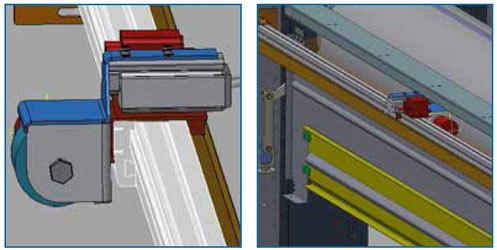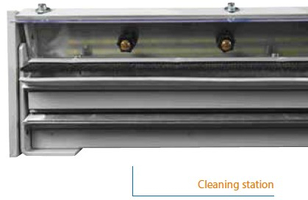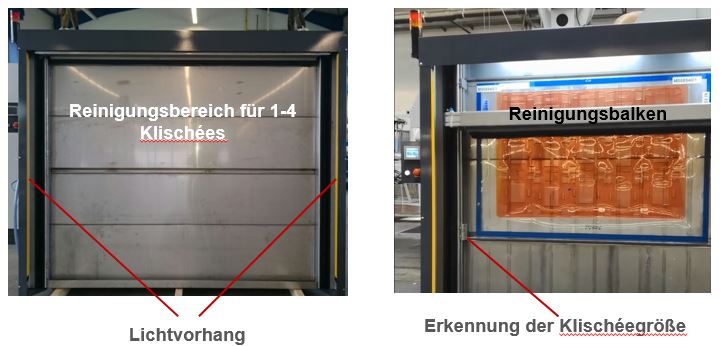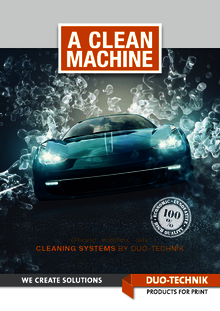CLEAN|CLICHÉ
// Save time and money
The cleaning of printing plates during your production process wastes a lot of time.
We asked some of our customers who didn’t have an automatic plate cleaning system to estimate how much of time they lose for washing plates, each year.They answered that: 20-25% of the effective machine production time is wasted for cleaning. To put that number into context: A print facility with a 2 shift operation of 3000 hr./year would need 600–750 hours/year just for plate cleaning. That’s time that the printing machine is not productive.

// Why do I need to clean so often?
There are 3 fundamental situations when plate cleaning is usually necessary:
- Cleaning after job set up due to ink drying on the plates during the approval process wait-time
- Interim cleaning after 3000-4000 sheets due to dust or dry ink defects
- Cleaning after the end of the job
Duo-Technik’s QPC is a machine-integrated system that cleans dry ink and dust defects from the print plates without stopping the machine. This quick cleaning process, during printing, takes about 2 minutes with only about 8-10 waste boards. However, final cleaning is not possible.
// What is it used for?
Cleaning of specific dust-related defects on the printing plates – can be used at the discretion of the operator during production
- Increases quality output while reducing the machine down-time required for cleaning
Continuous (automatic, cyclic) cleaning of the printing plates during production
- Particularly recommended for “process” jobs, to improve overall job quality while reducing down-time of the machine required for cleaning of dried ink on the plates.
Quick plate cleaning during a sheet feeder stop
- Faster startup of the machine after press jam up or feeder stop. Down-time for cleaning is reduced to a minimum; creating only 8-10 waste boards.
// How does it work?
The system consists of a moveable clea-ning head with a unique rotating sponge. The cleaning head travels along the prin-ting cylinder, removing dust and dried ink. The sponge head distance to the printing cylinder can be set through the touch panel in micrometers (0.1mm). After cleaning the printing plates, the cleaning head returns to the integrated docking station where the sponge is clea-ned waiting for the next cleaning cycle.

// What are its unique features?
The cleaning head is cleaned inside the printing machine
- resulting in a long lifetime of the cleaning head and sponge and reduced replacement costs.
- Not only does the cleaning head and sponge last longer their replacement costs are lower than competitive type products.
The cleaning head is automatically set to the printing plate thickness
- Shorter set up times necessary for job set-up.Optionally, the Duo-Technik Final Cleaning Station (FCS) can also be added.
The cleaning head can also be cleaned outside the machine
- Lower replacement spare part costs
//Optionally, the Duo-Technik Final Cleaning Station (FCS) can also be added!
Duo-Technik’s ACS is also a machine integrated system which is able to make interim plate cleaning which takes only 6 minutes and a effective final plate deep cleaning that takes only two minutes. The printing machine has to be stopped during the cleaning process.
// What is it used for?
he goal of the ACS system is not only to remove dust spots or dry ink but to deep clean the printing plates. This is especially recommended for long inline production runs. However the printing machine has to be stopped to do the cleaning. This is an interesting feature, since based on the actual ink condition, more or less ink will dry and accumulate on the printing plates and this is really difficult to remove with an in-production cleaning system
What should you expect?
- In-depth cleaning of all printing plates in 6 minutes
- The 3rd sheet after cleaning is commercial quality
- Quick final cleaning of wet printing plates in two minutes
- Final cleaning of the printing plates can take place during the set-up of a new job
- Metered make-up and controlled usage of soap for the cleaning cycle
- Printing plates are maintained in optimal condition

// How does it work?
- Using the special nozzles, a metered soap-water mixture is sprayed onto the printing plates
- The special nozzles eliminate the possibility of water dripping after the spray cycle
- A stationary cleaning brush is also located underneath the nozzles
- This is a closed-cycle cleaning process, with rubber seals, to ensure that any water and the waste water are contained.
- A vacuum chamber between brush and the seal evacuates the waste water. Each unit has a separate vacuum pump
- Integrated drying units dry the printing plates after the cleaning process
- The ACS is integrated with the print machine process control system, allowing the information regarding decks used and board widths to be preset automatically in the operator software menu. The operator can readjust individual parameters for each deck
- The operator can set additionally individual for each unit the widths
- The water and soap is automatically mixed by the unique integrated metering unit that is also included
With the Final Plate Cleaner you can optimize your cleaning of clichés outside the printing press. Whether locally at each printing machine or centrally for all printing presses, Duo-Technik offers all sizes of 1600 mm width up to 3600 mm in width. Also special sizes on request.
Starting Position:
- The operator clean the cliché next to the printing machine by hand
- or there is a manual central cleaning station for cliché in the factory
- The clichés are cleaned with hand brushes, water and soap (no defined cleaning, no defined application of water and soap, the clichés can be damaged by mechanical cleaning)
Advantages of a central usage of a FPC:
- Parallel cleaning of up to 4 clichés. This saves personnel costs.
- Defined cleaning and defined consumptions.
- Longer life time of clichés thanks to contactless cleaning.
Advantages of a decentral usage of a FPC:
- The operator has more time to control the production.
- Defined cleaning and defined consumption.
- Longer life time of clichés thanks to contactless cleaning.
// How a FPC looks like?

Example: Manual Cleaning, Central usage
500 Clichés per month, 6.000 clichés per year
5 minutes for manual cleaning
= 500 h cleaning per year
= 500 h * 40 EUR/h = 20.000 Euro
FPC Cleaning, Central Usage
500 Clichés per month, 6.000 clichés per year
1,5 minutes manual cleaning
= 150 h cleaning per year
= 150 h * 30 EUR/h = 4.500 Euro
(depreciation 30 TEUR/5 Jahren)
= 150 h * 40 EUR/h = 6.000 Euro
(personnel cost)
► 9.500 Euro savings per year
Duo-Technik sells for many years cleaning systems. So we were able to make positive and negative experiences with cleaning soaps for cliche. On base of all this experience we developed our own soap for cleaning. This soap cleans well and damages not the equipment. Test on your own.
Efficient and powerful cleaning action for printing plate

// Why you need an effective cleaner for printing plates?
Printing plates needs to be cleaned very often:
- Cleaning after setting due to dried-ink
- Cleaning after approximately 3,000 to 4,000 sheets for dust or dried-ink
- Cleaning at the end of a printing job
Our special cleaner masters these situations quickly and easily.
// Features
The Duo-Technik Ultimate-Cliché-Cleaner is an alkaline special cleaner for the thorough and safe cleaning of clichés. Dust and dried ink is removed without residues. This special cleaner is optimally matching to our Quick Plate Cleaner (QPC), our Final Plate Cleaner (FPC) and our Auto Clean System (ACS). It ensures a high production quality and reduces the downtime of the machine.
// Application
The cleaner should be in a mixing ratio of 1:10 diluted.
// Packaging
Available are the following package sizes:
30 liter / 200 liter / 1.000 liter (ask us for a free sample)


